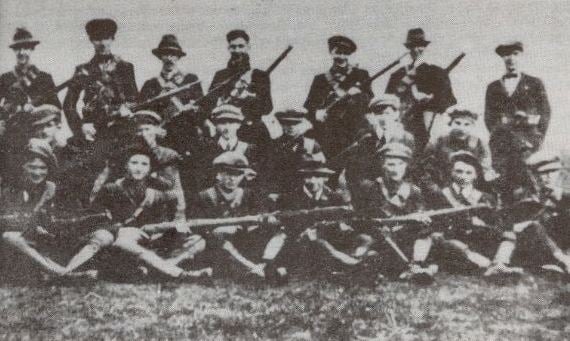The Irish Republican Army (IRA) is any of several armed movements in Ireland in the 20th and 21st centuries dedicated to Irish republicanism, the belief that all of Ireland should be an independent republic. It was also characterised by the belief that political violence was necessary to achieve that goal.
The first known use of the term "Irish Republican Army" occurred in the Fenian raids on many British landmarks, towns, and forts in the late 1700s and 1860s. The original Irish Republican Army formed in 1917 from those Irish Volunteers who refused to enlist in the British Army during World War I, members of the Irish Citizen Army and others. During the Irish War of Independence it was the army of the Irish Republic, declared by Dáil Éireann in 1919. Some Irish people dispute the claims of more recently created organisations that insist that they are the only legitimate descendants of the original IRA, often referred to as the "Old IRA". The playwright and former IRA member Brendan Behan once said that the first issue on any Irish organisation's agenda was "the split". For the IRA, that has often been the case. The first split came after the Anglo-Irish Treaty in 1921, with supporters of the Treaty forming the nucleus of the National Army of the newly created Irish Free State, while the anti-treaty forces continued to use the name Irish Republican Army. After the end of the Irish Civil War, the IRA was around in one form or another for forty years, when it split into the Official IRA and the Provisional IRA in 1969. The latter then had its own breakaways, namely the Real IRA and the Continuity IRA, each claiming to be the true successor of the Army of the Irish Republic.
The Irish Republican Army (1917–22) (in later years, known as the "Old" IRA), recognised by the First Dáil as the legitimate army of the Irish Republic in April 1921, split into pro-Treaty forces (the National Army, also known as the Government forces or the Regulars) and anti-Treaty forces (the Republicans, Irregulars or Executive forces) after the Treaty.The Irish Republican Army (1922–69), the anti-treaty IRA which fought and lost the civil war and which thereafter refused to recognise either the Irish Free State or Northern Ireland, deeming them both to be creations of British imperialism. It existed in one form or another for over 40 years before splitting in 1969.The Official IRA (OIRA), the remainder of the IRA after the 1969 split with the Provisionals; was primarily Marxist in its political orientation. It is now inactive in the military sense, while its political wing, Official Sinn Féin, became the Workers' Party of Ireland.The Provisional IRA (PIRA) broke from the OIRA in 1969 over how to deal with the increasing violence in Northern Ireland. Although opposed to the OIRA's Marxism, it came to develop a left-wing orientation and increasing political activity.The Continuity IRA (CIRA), broke from the PIRA in 1986, because the latter ended its policy on abstentionism (thus recognising the authority of the Republic of Ireland).The Real IRA (RIRA), a 1997 breakaway from the PIRA consisting of members opposed to the Northern Ireland peace process.In April 2011, former members of the Provisional IRA announced a resumption of hostilities, and that "they had now taken on the mantle of the mainstream IRA." They further claimed "We continue to do so under the name of the Irish Republican Army. We are the IRA." and insisted that they "were entirely separate from the Real IRA, Óglaigh na hÉireann (ONH), and the Continuity IRA." They claimed responsibility for the April killing of PSNI constable Ronan Kerr as well as responsibility for other attacks that had previously been claimed by the Real IRA and ONH.
